
|
| |
|
|
|
|
 |
|
|
1st Mechanised Corps
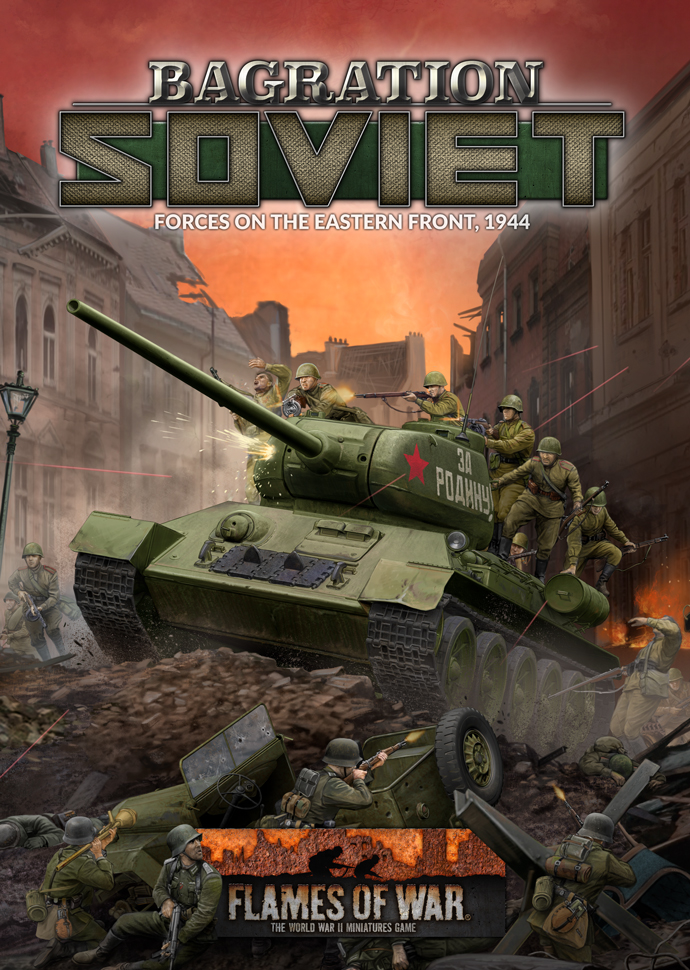 |
Soviet 1st Mechanised Corps during Operation Bagration
Bagration: Soviet
The Red Army’s 1-y Mechanizirovanniy Korpus (1st Mechanized Corps) formed the leading edge of the Sickle. Threatening Minsk from the south, the Soviet advance sliced just above the Pripyat Marshes hoping to cut off Minsk from the southwest. They harried the retreating German 9. Armee from the ashes of Bobruisk, on to Slutsk, and then finally to Baranovichi.
The southern exploitation spearhead was lead by the Pliev Cavalry-Mechanised Group consisting of the 1st Mechanised Corps and the 4th Guards Cavalry Corps. The cavalry-mechanised groups were put together for their speed and mobility, a great advantage during the chaos of an enemy retreat where it would be speeding through the enemy rear areas. They raced west towards Baranovichi on 24 June cutting the southern flank of the fortress city of Minsk by 5 July.
|
|
The 1st Mechanised Corps was formed in September 1942 from the 27th Tank Corps. It took part in the Battle of Kursk in 1943 and then during the Kharkov operations of August 1943, in which the corps was part of the 53rd Army. It then took part in the advance on the Dnepr as part of the 53rd Army and then the 37th Army. In January 1944 it went into reserve to refit before taking part in Operation Bagration as part of the Pliev Cavalry-Mechanised Group of the 1st Byelorussian Front.
During Operation Bagration the group was added to Rokossovsky’s 1st Byelorussian Front and led the exploitation towards Baranovichi, to the southwest of Minsk. Along with the 28th Army, the Pliev Cavalry-Mechanised Group was to drive west for Slutsk. It initially faced the German 36. Infanteriedivision, an under-strength unit due to its involvement in heavy fighting in 1943.
Operation Bagration
On the afternoon of 24 June the Pliev Cavalry-Mechanised Group was committed to the battle in support of the 28th Army against the German 129. Infanteriedivision of the XXXXI Panzerkorps. By the evening the tanks of the Pliev Cavalry-Mechanised Group had advanced 20km west.
|
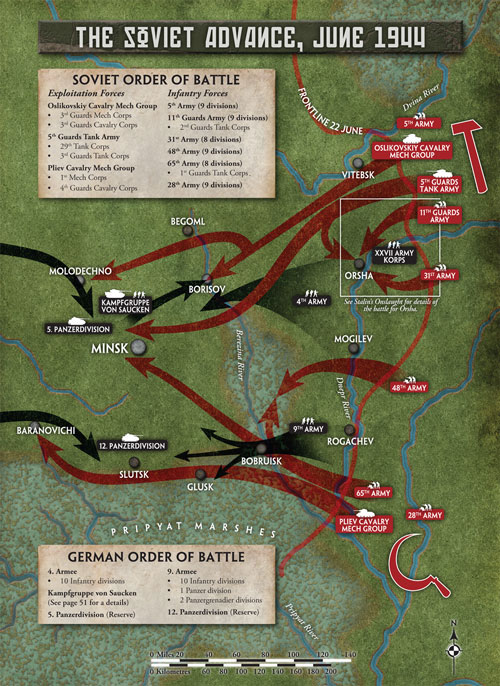 |
| On 25 June the Pliev Cavalry-Mechanised Group moved through the gap opened by the Soviet 28th and 65th Armies. During the afternoon they quickly advanced pursuing the German 35. Infanteriedivision. At 1630 hours the group passed through the 28th Army and forward towards Glusk against little opposition. The group advanced 30km the first day and 40km on 26 June. They cut roads south and southwest of Bobruysk and crossed the railroad south of Bobruysk by the evening of 26 June. |
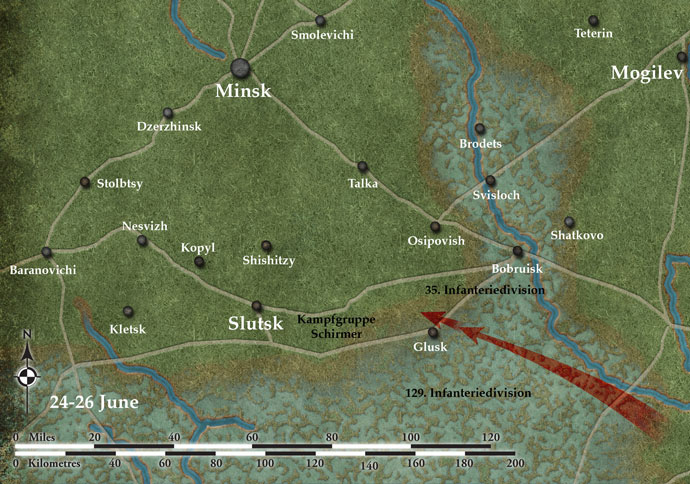 |
 |
On 26 June the group, along with the 3rd Guards Corps forces, pushed the German 35. Infanteriedivision all the way back to the Ptich River, a distance of more than 40km. This left a 40km gap in the German line, which they quickly exploited. The gap split the lines of the German XXXXI Panzerkorps, driving a wedge between the 36. and 35. Infanterie divisions, south of Bobruysk. At 1500 the group had crossed the river north of Glusk, threatening to outflank both the 35. and 129. Infanterie divisions. The cavalry of the group took Glusk and continued to move west unopposed. |
| The German 129. Infanteriedivision was forced to turn north to protect the northern flank of the LV Korps from the marauding Soviet mobile forces. |
27 June saw the 1st Mechanised Corps move into Glusk driving back the battered remnants of the German 35. Infanteriedivision. By 1700 Soviets were pouring through a gap north of Glusk towards Slutsk.
On 28 June the Pliev Cavalry-Mechanised Group broke through the German LV Korps. |
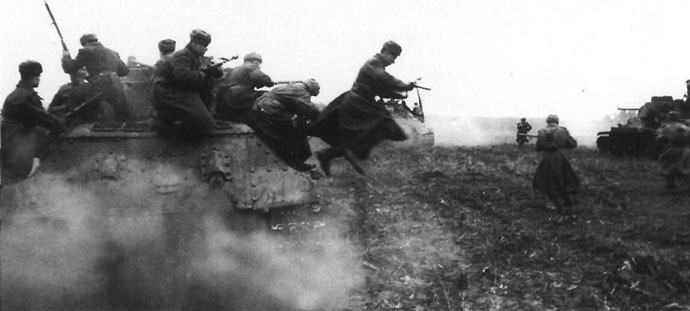 |
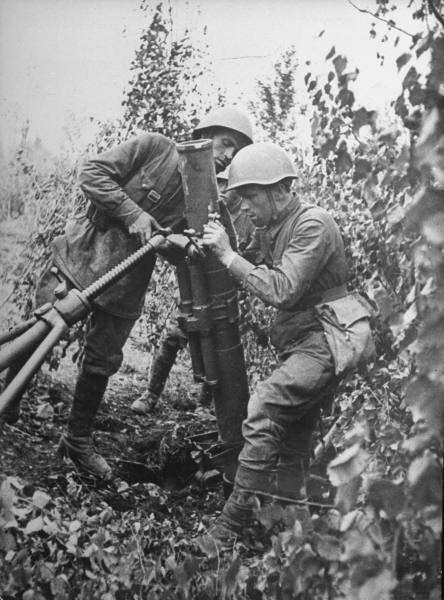 |
By the evening of 28 June cavalry elements of the Pliev Cavalry-Mechanised Group were on the outskirts of Slutsk, an important railhead for German units coming from the south. German Kampfgruppe Schirmer was attempting to delay the advance of the 1st Mechanised Corps and 28th Army, but by 2200 hours cavalry had crossed the river at Slutsk and the 1st Mechanised Corps had joined the attack from Glusk.
On 30 June the Pliev Cavalry-Mechanised Group drove Kampfgruppe Harteneck out of Slutsk. Counterattacks by the German 5. Reiter-Regiment (cavalry regiment) retook the western edges of the town from the Soviet cavalry. After the town was taken the 1st Mechanised Corps was sent southwest towards Baranovichi.
In the meantime German reinforcements had arrived in Baranovichi. The 4. Panzerdivision pushed down the main road to Slutsk to block it 20km from the town. The 1st Hungarian Cavalry Division and the German 28. Infanteriedivision were also on their way to help defend Baranovichi.
As reinforcements streamed in to the Baranovichi area the fighting between the 4. Panzerdivision and 1st Hungarian Cavalry Division, and the Pliev Cavalry-Mechanised Group intensified. Kampfgruppe Harteneck, including the Hungarians, halted the advance of the 1st Mechanised Corps at Kletsk (20km south of Nesvizh).
|
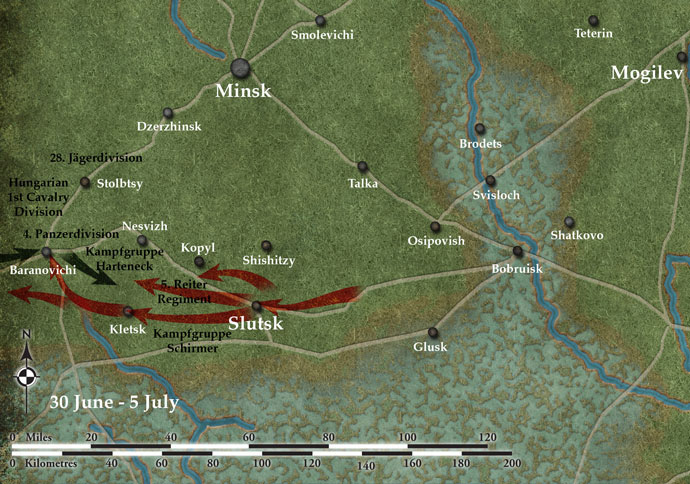 |
|
Other elements of the 1st Mechanised Corps were more successful further to the southwest where forces drove towards Baranovichi, threatening the rear of Germans around Stolbtsy, where they had thrown together a defensive line.
The arrival of the Axis reinforcement had finally halted the advance of the Pliev Cavalry-Mechanised Group and 28th Army following behind to secure the mobile group’s flanks. On average the group had advanced 20km per day, but the Germans finally stabilised the defence around Stolbtsy on 3 July.
On July 3 the 1st Mechanised Corps continued the advance south of Baranovichi. The 4th Guards Cavalry Corps encountered Kampfgruppe von Vormann (elements of 1st Hungarian Cavalry Division, 4. Panzerdivision, 28. Jägerdivision and 3. Reiter-Brigade) at Baranovichi. By 5 July the Germans had been driven back and the Pliev Cavalry-Mechanised Group was on the road to Slonim further west. The arrival of German reinforcements made the Germans more willing to give ground to buy time, which inturn slowed the rate of the Soviet advance.
5th Guards Tank Army…
3rd Guards Mechanised Corps…
|
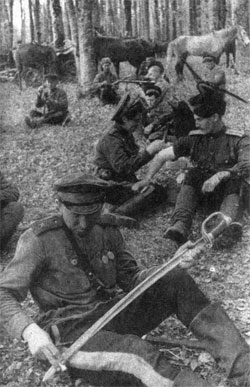 |
Last Updated On Thursday, March 11, 2021 by Wayne at Battlefront
|
|
|